This CE Center article is no longer eligible for receiving credits.
Security
Security against man-made and natural hazards is a growing concern, and entry doors are a key focus of that concern for every building owner in both public and private sectors. Most revolving door manufacturers offer a variety of night locking options that can ensure the building is securely closed during non-opening hours. Options include different types of locking mechanisms that secure the door wings in their standard, resting position and night sliding doors that close over the throat opening of the revolving door. Doors can be locked from a remote location, and access control systems can be integrated with the door to allow authorized users to unlock and enter or exit the building. Today, many employee-only entrances use security revolving doors to prevent tailgating and piggybacking, which are unauthorized, and sometimes forceful, entry via a separate compartment or in the same compartment as an authorized person, respectively. Vandal- and bullet-resistant glass is also available.

Image courtesy of Boon Edam
All-glass revolving doors are well-suited for a glass facade.
In other applications, fewer safety measures and a minimal impact may be allowable in order to improve the flow of people through the door. Manufacturers can advise on what safety measures are advisable for a specific project.
Recommended Surrounding Features
Building overhangs provide shelter from weather and keep snow and rain from getting inside the door, and are a popular strategy in colder sections of the country. However, as described earlier, interior throat opening or keyhole connections can create the same benefit within the entry itself, making for a simpler, more cost-effective solution by requiring less of an exterior overhang to be built. In addition, if access control is used, an overhang provides protection during the brief pause when a user must gain authorization prior to entering a security revolving door.
Adequate attention should also be paid to flooring. While revolving doors require the floor surface beneath them to be perfectly level to ensure proper operation, there are other considerations. Using different flooring materials for the circular area occupied by the revolving door itself visually signifies to users the actual path of the moving door wings and makes for less confusion and hesitation upon entering. The installation of the matting materials at the exterior and interior will help avoid slips and falls. Many buildings also employ stainless steel floor grates on either the exterior or interior side of the door or even under the entire door to collect dirt and debris before entry in order to decrease maintenance costs. Grating or matting that continues 10 feet or more into the interior space can also help qualify for LEED IEQ5 (Indoor chemical and pollutant source control).
Capacity and Type of Use
While the above concerns are certainly to be considered, the biggest issues in the specification of a revolving door are capacity and character of expected traffic. Obviously, the traffic expected in a small office building will be very different than that expected at an airport terminal. Architects will have to consider how many and what type of people are expected to enter and exit a facility. Will rush hours be a concern or will traffic be spread throughout the day? Will doors have to accommodate individuals with luggage or shopping carts? Are hospital gurneys an issue? Capacity is based on type of facility and user demographic. Slower capacities are generally applicable for facilities that will accommodate families, children, the elderly or the disabled, including museums, hospitals, transit systems or airports, restaurants or retail establishments and hotels and casinos. These are all situations in which users may be entering the facility for the first time and need time to adjust or get their bearings in unfamiliar surroundings. In addition, each of these user categories may be further constrained by luggage, wheelchairs, and packages and be slowed by their own or the needs of members of their group.
Optimum capacity is reserved for “trained traffic,” or users who are familiar with the doors and the building and are either residents or employees who come and go on a regular basis.
In general, small office buildings, restaurant, and high-end retail use three- or four-wing manual revolving doors. Either two- three- or four-wing automatic revolving doors are more appropriate for hotels, hospitals, airports, and large retail stores.
Capacity and User Comfort
Factors that affect capacity and user comfort are diameter of the drum, throat opening, manual or automatic operation, compartment size and number of door wings, ANSI code requirements for maximum rotation speed and safety sensors, and to some degree the positioning drive on manual revolving doors.
Traffic Type Capacity
This is expressed in terms of direction x number of people per direction per minute. For example, “1x15” refers to a one-way door that allows 15 people through in one minute, for a total of 15 people/minute. One-way doors, however, have limited application. The more typical capacity equation is “2x24,” signifying a two-way door that allows 24 people per direction in one minute for a total of 48 people/minute.
When calculating throughput, an individual's comfort zone should be considered. Most people would prefer a comfort zone around them of 4 feet diameter or 2 feet in front and back of them. The result is a circle surrounding the user that takes up about 12 square feet. To roughly gauge the capacity of a revolving door you can divide a compartment area by 12 square feet and then multiply the number of compartments by the recommended number of revolutions per minute.
Diameter
The first element that influences capacity is diameter. With automatic doors, larger diameter increases capacity. However, with manual doors, increases in diameter generally work to increase user comfort, as they are intended for one user per compartment. The heavier weight of increased diameter doors actually make the door slightly harder to push, lowering the RPMs and thus slightly decreasing the number of people that move through. It is interesting to note that when the diameter of a door is increased by a certain ratio, the area of each compartment increases by a much greater ratio. Thus, for a slightly wider opening in the building envelope, the comfort and/or the capacity can be greatly improved. Note that in the accompanying chart, for a manual three-wing door, the 7-foot diameter accommodates the minimum comfort zone of a 12-square-foot area. Yet increasing the diameter by 14 percent to 8 feet yields a 31 percent larger compartment for greatly improved comfort.
A 7-foot manual four-wing door would have a much tighter fit; in this case, a slightly larger diameter is recommended for user comfort.
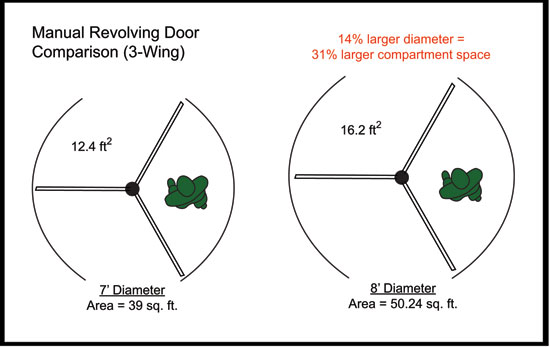
Image courtesy of Boon Edam
Throat Opening
Another factor affecting capacity is the throat opening. By design, a four-wing door has a wider throat opening than a three-wing door of similar diameter. The wider throat opening is easier to pass through and therefore increases user comfort and capacity. In smaller-diameter doors, the throat opening width becomes more of an influential factor in determining capacity. In addition, smaller three-wing doors may not provide enough space in the throat opening for emergency egress which we will discuss later.
With automatic revolving doors, larger diameters translate to increased comfort and throughput. Even modest increases in diameter translate to substantially increased user comfort and capacity. Consider a 10-foot-diameter, three-wing automatic revolving door vs. a similar door of 14 feet in diameter. The larger door results in a compartment size of nearly 47 square feet, nearing 200 percent larger than the 10-foot diameter door. Using the rule of thumb of dividing each compartment size by 12 to get the number of comfortable users, the smaller door can really only manage two users, while the larger door can handle four.
The accompanying chart shows the effect of changing diameter, throat size, and compartment size on the maximum RPMs and the capacity per minute for automatic doors, showing the best way to divide the geometry of the drum for a desired throughput. In the chart, the compartment size number reflects the loss of a few feet that is taken up by the center showcase. Assuming a comfort zone of 12 square feet, the numbers shown are approximately correct, though they do not take into account the sensors on the trailing door wing which we will discuss later.
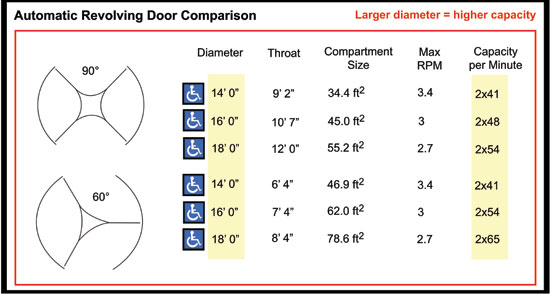
Image courtesy of Boon Edam
Manual or Automatic
Another parameter to consider in determining capacity is whether manual or automatic doors are required. Manual doors generally accommodate one person per compartment, and are most suitable for low-traffic applications. In certain circumstances such as museum exhibits, courthouses or airport terminal exits, an automatic one-way door can be used as a kind of security measure where users leave through the door but are not able to be readmitted. Cost is another factor in determining whether an automatic or manual door is selected. Building owners may prefer the lower price point coupled with the lower maintenance costs of a manual revolving door compared to the higher price and maintenance costs of an automatic door.
Compartment Size and Shape
Designers should factor in how compartment size affects wheelchair access, rolling luggage, shopping carts, and emergency egress, etc. While in general it is true that larger compartments afford more comfort or accommodate higher capacities, there may be caveats in certain situations. Also, as mentioned earlier, in comparing smaller manual doors of the same diameter, the throat opening of the four-wing is greater than that of the three-wing. The throat opening of three-wing doors under 7 feet diameter is not wide enough to meet life safety codes when the door wings are collapsed during an emergency.
ANSI code requirements
The American National Standards Institute places safety restrictions on the rotation speed of manual and automatic revolving doors and also requires presence detection sensors for automatic doors that can slow or stop the door when objects or people are close to making contact with the door. These requirements are discussed in more detail later in regard to safety however it is worth mentioning briefly here their influence on throughput.
Positioning Drive
In manual doors, an optional positioning drive system will rotate the door to the standard “X” position after use, which eliminates user confusion upon entering the door, and enables the user to step in and keep pushing rather than hesitating. These same positioning drive systems may also incorporate a power assist function which will help users push the door with reduced effort.
Let's face it. The built environment is an energy guzzler. The U.S. Green Building Council states that U.S. buildings have a considerable impact on natural resources. Buildings account for 40 percent of primary energy usage and 72 percent of electricity consumption as well as 32 percent of CO2 emissions and 13.6 percent potable water consumption. The type of doors selected can have a big impact on a building's energy profile. Revolving doors can be eight times as energy efficient as their hinged counterparts—all while allowing large numbers of people to pass in and out, boosting security, and adding architectural interest to even the grandest façade. This article will discuss the green features of revolving doors and consider design elements as they relate to user comfort and safety. Also covered will be code requirements and a checklist of must-dos in properly specifying a revolving door for a given project.
The ABCs of Revolving Doors
A revolving door typically consists of doors that hang on a central shaft and rotate around a vertical axis within a cylindrical enclosure called a drum. There are usually two, three, or four panels called door wings which typically incorporate glass. The opening of the drum enclosure is referred to as the throat opening.
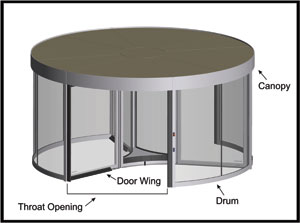
Image courtesy of Boon Edam
Manual revolving doors rotate with pushbars, causing all wings to rotate. Large-diameter revolving doors rotate automatically and can accommodate strollers, wheel chairs, and wheeled luggage. A speed control or “governor” mounted in either the ceiling or the floor prevents moving the doors at an unsafe speed. Automatic revolving doors are powered above or below the central shaft, or along the perimeter. Sensors in the door wings and the enclosure frame ensure that the speed with which the door revolves is limited. Other sensors can prevent or minimize the force of impact of the door wing on users. These settings can be customized to suit a building's specific requirements; for applications where children, elderly people, or people with special needs form a large part of the user profile, preventing any impact is paramount.

Image courtesy of Boon Edam
Revolving doors can be eight times as energy efficient as their hinged counterparts, while boosting throughput, security, and architectural interest.
Not only can revolving doors efficiently handle bi-directional pedestrian traffic and reduce energy costs by maintaining an airlock, they improve comfort for building occupants and offer more usable space at building entrances compared to vestibules—all attributes that have been proven for more than 125 years. Revolving doors were invented in Philadelphia in 1888 by American-born Theophilus Van Kannel to reduce air infiltration. “As the door fits snugly in the casing,” Van Kannel's 1888 patent states, “it is perfectly noiseless in its operation and effectually prevents the entrance of wind, snow, rain or dust either when it is closed or when persons are passing through it.” The original motto of Van Kannel's company was “Always open, always closed,” that is, always open to people, always closed to the elements.
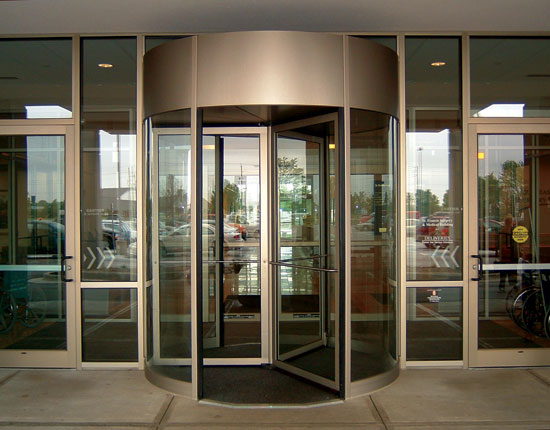
Image courtesy of Boon Edam
For a clean look, architects can specify stainless steel or other type of metal.
A basic understanding of the way air behaves in a building sheds light on the benefits of revolving doors. Generally speaking, air flows in and out of a building because of differences in air pressure and humidity in what is known as the stack effect. In the winter, heated air rises toward the top of a building and as long as there are any openings on the ground floor, cold air rushes in to replace the heated air. The opposite happens in the summer, with the cold air flowing out the front doors. In addition, air flows through the building when doors, vents, or windows are open; this is known as a wind tunnel effect. Regular foot traffic through swinging or sliding doors can result in air leaks of up to thousands of cubic feet per minute, requiring more air to be heated or cooled.
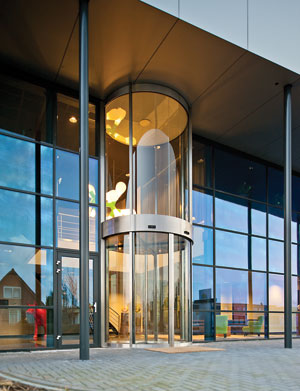
Image courtesy of Boon Edam
Dimensional elements can be selected to create a distinctive look.
Granted, a revolving door isn't airtight, but the barrier it creates makes the impact of that air pressure differential less important. Every time the door spins, some air will leave the building and some will come in, but overall, much less passes through a revolving door than a swing door. Not only are drafts eliminated, noise and air pollution minimized, and dirt and debris kept out of the building, but revolving doors also counter the effects of stack pressure, which increases in taller buildings. Where stack pressure is prevalent, the ease of operation of pushing a revolving door compared to pulling or pushing hinged or swinging doors is another key driver in selecting a revolving door system as the primary point of entry.
Energy Saved by Revolving Doors: The MIT Study
In 2006, a team of graduate students at MIT conducted an analysis of door use in one building on campus, E25, where they found just 23 percent of visitors used the revolving doors. According to MIT's calculations, the swinging door allowed as much as eight times more air to pass through the building than the revolving door. According to the April 2009 MIT Tech Talk publication, “Research from MIT students indicates that if everyone were to use the revolving doors in Building E25, for example, MIT would save almost $7,500 in natural gas a year. That's enough to heat five houses over the same timeframe, and it also adds up to nearly 15 tons of CO2.”
According to the study, the revolving door stops conditioned air from moving freely. In contrast, an open swing door is like letting go of a balloon—the air rushes out of the opening. With a revolving door, only the air in the chamber with the person going through the door is transferred. The accompanying figure illustrates how air is transferred in and out of a building. Cold air is more dense than warm, resulting in a pressure differential (“stack pressure”) that moves conditioned air through open doors and cracks in seals. Wind blowing on the building adds to this pressure differential.
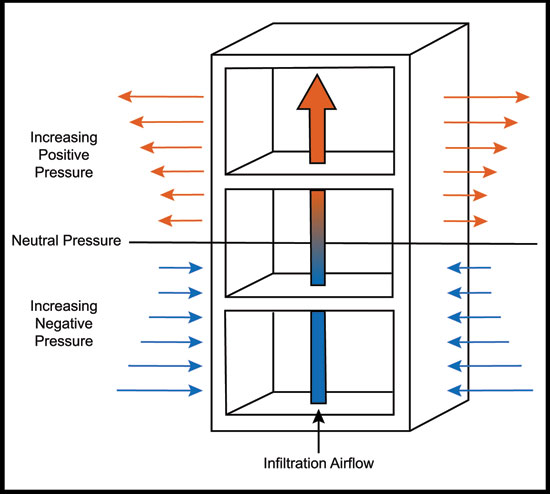
Image courtesy of Boon Edam
The MIT findings on how revolving door usage affects energy consumption are shown in the accompanying table. It is worth noting that if all people entering and exiting the building under study used revolving doors, the energy savings would be 74 percent, preventing the release of more than 14 tons of CO2. However, these energy savings do not amount to 88 percent, as might be expected from the eight times less air transferred through the revolving door as through the swing doors. That is due to the fact that the revolving doors leak more than swing doors, lowering their overall efficiency slightly.
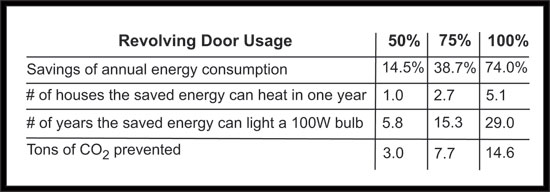
Image courtesy of Boon Edam
Energy savings depend on the weather. Heating is less efficient than cooling, and the indoor/outdoor temperature differential is larger in the winter than in the summer, so more energy is saved in the winter. Windy days are worse than calm ones. Still, every time a user walks through a door and feels that rush of “wind,” they are feeling energy leave the building.
The accompanying chart (see the online version of this course) shows monthly-averaged total air leakages through MIT's Building E25 doors, with a revolving door usage of 23.3 percent. The watt-hour (symbolized Wh) is a unit of energy equivalent to one watt (1 W) of power expended for one hour (1 h) of time. The watt-hour is not a standard unit in any formal system, but it is commonly used in electrical applications.

Image courtesy of Boon Edam
Research showed that the average heat transfer per swing door passage is 78Wh (267 BTU), or the equivalent of 1.3 hours of light from a desk lamp; 4.3 hours of light from a compact fluorescent bulb; driving a car 306 feet; or jogging half a mile. Revolving doors, on the other hand, show reduced air infiltration, which translates to less energy wasted and consequently greater financial savings. Industry watchers maintain that revolving doors perpetually save money for the owner, with an average payback period of two to five years.

Image courtesy of Boon Edam
Key Elements of Revolving Door Design
A building's entrance is its calling card, its first contact with visitors. As such its design is a key element to its success. In order to specify the right revolving door for a given project, several factors must be considered.
Façade
Revolving doors are an opportunity to enhance the drama of a building façade. Today's all-glass facades are the most popular building design and have virtually universal aesthetic appeal. Available in various widths and heights, an all-glass door complements the appeal of a glass façade. Minimal stainless steel trim and patch fittings contribute to a clean, sleek look. All-glass doors are naturally suitable for modern glass facades but they can also serve as a dramatic element in more traditional or classic designs. Vandalism-or burglary-resistant glass is also available. However, it is critical to note though that, by code, all glass doors in the U.S. are manually operated.
Another very common façade is a storefront which typically includes finished metal or painted elements with glass windows. To complement this style, the more traditional aluminum and glass revolving door works well as the frame can be either anodized or powder coated in a wide variety of colors to match the storefront. Architects interested in a more polished look can select cladding in stainless steel or another type of metal, such as bronze. Door wings and the drum walls can be inlaid with clear or tinted glass and where appropriate the drum can be in constructed of solid metal panels.
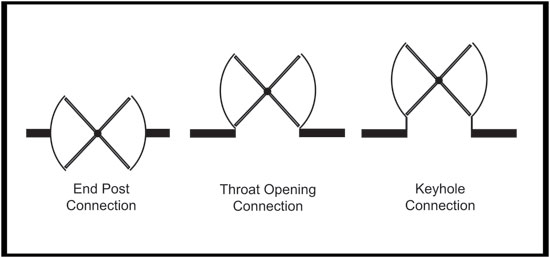
Image courtesy of Boon Edam
Revolving doors can be connected to the building at mid post, throat opening, or by keyhole configuration.
Connections to the Building
Revolving doors can be connected to buildings at mid-post, throat opening, and in several “keyhole” configurations including standard, double-bent glass, and angled. The common connection used is the midpost. However, since half of the door protrudes beyond the building envelope, it would not be recommended where pedestrian space is limited or without a protective building overhang. An interior keyhole may be used when the lobby is large enough that the door will not encroach on a nearby elevator lobby, stairs, and escalators.

Image courtesy of Boon Edam
Building overhangs and floor grates or mats are recommended to protect people and reduce debris infiltration.
With an interior throat opening or keyhole connection, a door is completely mounted into the interior of a building and there is no part of the door itself that is exposed beyond the building envelope. This eliminates any rain or snow accumulating on the top of the door and greatly reduces accumulation inside the door. It also greatly benefits useful life and reduces the amount of maintenance needed. Finally, an interior mounted door creates a mini overhang or awning effect that protects users from rain or snow just before they enter the door.
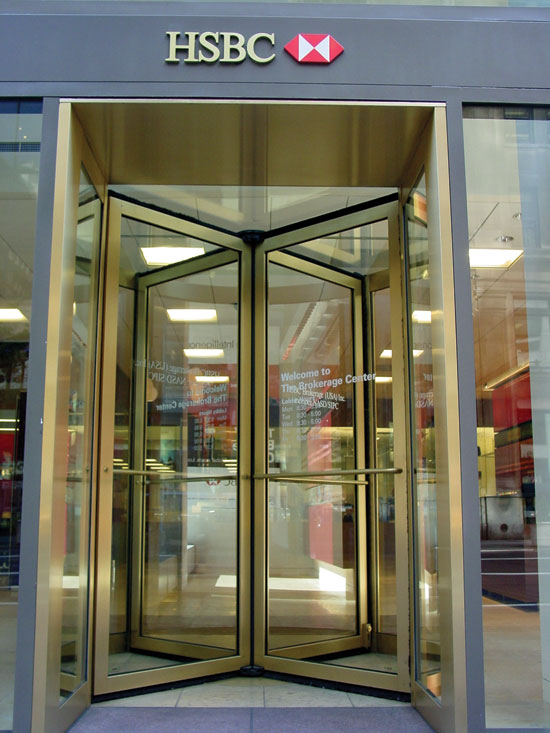
Image courtesy of Boon Edam
An interior keyhole connection provides a mini overhang to protect people and door from the elements.
Brand
Brand is important to all enterprises, and revolving doors can be selected to enhance an organization's brand identity among users. Doors can showcase trim color and glass options, including custom logo screen printing on the glass, custom pushbars, and canopy finishing and design in a way that emphasizes the visual identity of a company or organization. Automatic revolving doors with glass “showcases” in them allow space for seasonal promotions or special events.
Dimensional Elements
The diameter of the door, the height of the door opening and canopy, sidewall enclosure base, bottom rail sideline, and the width of vertical styles can all be optimized to create the desired look and complement surrounding building elements and doors. When these dimensional elements are specified with consideration of the surrounding features, a fluid and harmonious sightline is created. For dramatic appeal, an additional curved glass enclosure can be constructed above the revolving door to greatly elevate the door's visual impact.

Image courtesy of Boon Edam
Revolving doors have maintained an “always open to people, always closed to the elements” approach since 1888.
Security
Security against man-made and natural hazards is a growing concern, and entry doors are a key focus of that concern for every building owner in both public and private sectors. Most revolving door manufacturers offer a variety of night locking options that can ensure the building is securely closed during non-opening hours. Options include different types of locking mechanisms that secure the door wings in their standard, resting position and night sliding doors that close over the throat opening of the revolving door. Doors can be locked from a remote location, and access control systems can be integrated with the door to allow authorized users to unlock and enter or exit the building. Today, many employee-only entrances use security revolving doors to prevent tailgating and piggybacking, which are unauthorized, and sometimes forceful, entry via a separate compartment or in the same compartment as an authorized person, respectively. Vandal- and bullet-resistant glass is also available.

Image courtesy of Boon Edam
All-glass revolving doors are well-suited for a glass facade.
In other applications, fewer safety measures and a minimal impact may be allowable in order to improve the flow of people through the door. Manufacturers can advise on what safety measures are advisable for a specific project.
Recommended Surrounding Features
Building overhangs provide shelter from weather and keep snow and rain from getting inside the door, and are a popular strategy in colder sections of the country. However, as described earlier, interior throat opening or keyhole connections can create the same benefit within the entry itself, making for a simpler, more cost-effective solution by requiring less of an exterior overhang to be built. In addition, if access control is used, an overhang provides protection during the brief pause when a user must gain authorization prior to entering a security revolving door.
Adequate attention should also be paid to flooring. While revolving doors require the floor surface beneath them to be perfectly level to ensure proper operation, there are other considerations. Using different flooring materials for the circular area occupied by the revolving door itself visually signifies to users the actual path of the moving door wings and makes for less confusion and hesitation upon entering. The installation of the matting materials at the exterior and interior will help avoid slips and falls. Many buildings also employ stainless steel floor grates on either the exterior or interior side of the door or even under the entire door to collect dirt and debris before entry in order to decrease maintenance costs. Grating or matting that continues 10 feet or more into the interior space can also help qualify for LEED IEQ5 (Indoor chemical and pollutant source control).
Capacity and Type of Use
While the above concerns are certainly to be considered, the biggest issues in the specification of a revolving door are capacity and character of expected traffic. Obviously, the traffic expected in a small office building will be very different than that expected at an airport terminal. Architects will have to consider how many and what type of people are expected to enter and exit a facility. Will rush hours be a concern or will traffic be spread throughout the day? Will doors have to accommodate individuals with luggage or shopping carts? Are hospital gurneys an issue? Capacity is based on type of facility and user demographic. Slower capacities are generally applicable for facilities that will accommodate families, children, the elderly or the disabled, including museums, hospitals, transit systems or airports, restaurants or retail establishments and hotels and casinos. These are all situations in which users may be entering the facility for the first time and need time to adjust or get their bearings in unfamiliar surroundings. In addition, each of these user categories may be further constrained by luggage, wheelchairs, and packages and be slowed by their own or the needs of members of their group.
Optimum capacity is reserved for “trained traffic,” or users who are familiar with the doors and the building and are either residents or employees who come and go on a regular basis.
In general, small office buildings, restaurant, and high-end retail use three- or four-wing manual revolving doors. Either two- three- or four-wing automatic revolving doors are more appropriate for hotels, hospitals, airports, and large retail stores.
Capacity and User Comfort
Factors that affect capacity and user comfort are diameter of the drum, throat opening, manual or automatic operation, compartment size and number of door wings, ANSI code requirements for maximum rotation speed and safety sensors, and to some degree the positioning drive on manual revolving doors.
Traffic Type Capacity
This is expressed in terms of direction x number of people per direction per minute. For example, “1x15” refers to a one-way door that allows 15 people through in one minute, for a total of 15 people/minute. One-way doors, however, have limited application. The more typical capacity equation is “2x24,” signifying a two-way door that allows 24 people per direction in one minute for a total of 48 people/minute.
When calculating throughput, an individual's comfort zone should be considered. Most people would prefer a comfort zone around them of 4 feet diameter or 2 feet in front and back of them. The result is a circle surrounding the user that takes up about 12 square feet. To roughly gauge the capacity of a revolving door you can divide a compartment area by 12 square feet and then multiply the number of compartments by the recommended number of revolutions per minute.
Diameter
The first element that influences capacity is diameter. With automatic doors, larger diameter increases capacity. However, with manual doors, increases in diameter generally work to increase user comfort, as they are intended for one user per compartment. The heavier weight of increased diameter doors actually make the door slightly harder to push, lowering the RPMs and thus slightly decreasing the number of people that move through. It is interesting to note that when the diameter of a door is increased by a certain ratio, the area of each compartment increases by a much greater ratio. Thus, for a slightly wider opening in the building envelope, the comfort and/or the capacity can be greatly improved. Note that in the accompanying chart, for a manual three-wing door, the 7-foot diameter accommodates the minimum comfort zone of a 12-square-foot area. Yet increasing the diameter by 14 percent to 8 feet yields a 31 percent larger compartment for greatly improved comfort.
A 7-foot manual four-wing door would have a much tighter fit; in this case, a slightly larger diameter is recommended for user comfort.

Image courtesy of Boon Edam
Throat Opening
Another factor affecting capacity is the throat opening. By design, a four-wing door has a wider throat opening than a three-wing door of similar diameter. The wider throat opening is easier to pass through and therefore increases user comfort and capacity. In smaller-diameter doors, the throat opening width becomes more of an influential factor in determining capacity. In addition, smaller three-wing doors may not provide enough space in the throat opening for emergency egress which we will discuss later.
With automatic revolving doors, larger diameters translate to increased comfort and throughput. Even modest increases in diameter translate to substantially increased user comfort and capacity. Consider a 10-foot-diameter, three-wing automatic revolving door vs. a similar door of 14 feet in diameter. The larger door results in a compartment size of nearly 47 square feet, nearing 200 percent larger than the 10-foot diameter door. Using the rule of thumb of dividing each compartment size by 12 to get the number of comfortable users, the smaller door can really only manage two users, while the larger door can handle four.
The accompanying chart shows the effect of changing diameter, throat size, and compartment size on the maximum RPMs and the capacity per minute for automatic doors, showing the best way to divide the geometry of the drum for a desired throughput. In the chart, the compartment size number reflects the loss of a few feet that is taken up by the center showcase. Assuming a comfort zone of 12 square feet, the numbers shown are approximately correct, though they do not take into account the sensors on the trailing door wing which we will discuss later.

Image courtesy of Boon Edam
Manual or Automatic
Another parameter to consider in determining capacity is whether manual or automatic doors are required. Manual doors generally accommodate one person per compartment, and are most suitable for low-traffic applications. In certain circumstances such as museum exhibits, courthouses or airport terminal exits, an automatic one-way door can be used as a kind of security measure where users leave through the door but are not able to be readmitted. Cost is another factor in determining whether an automatic or manual door is selected. Building owners may prefer the lower price point coupled with the lower maintenance costs of a manual revolving door compared to the higher price and maintenance costs of an automatic door.
Compartment Size and Shape
Designers should factor in how compartment size affects wheelchair access, rolling luggage, shopping carts, and emergency egress, etc. While in general it is true that larger compartments afford more comfort or accommodate higher capacities, there may be caveats in certain situations. Also, as mentioned earlier, in comparing smaller manual doors of the same diameter, the throat opening of the four-wing is greater than that of the three-wing. The throat opening of three-wing doors under 7 feet diameter is not wide enough to meet life safety codes when the door wings are collapsed during an emergency.
ANSI code requirements
The American National Standards Institute places safety restrictions on the rotation speed of manual and automatic revolving doors and also requires presence detection sensors for automatic doors that can slow or stop the door when objects or people are close to making contact with the door. These requirements are discussed in more detail later in regard to safety however it is worth mentioning briefly here their influence on throughput.
Positioning Drive
In manual doors, an optional positioning drive system will rotate the door to the standard “X” position after use, which eliminates user confusion upon entering the door, and enables the user to step in and keep pushing rather than hesitating. These same positioning drive systems may also incorporate a power assist function which will help users push the door with reduced effort.
Code Requirements for User Comfort and Safety
A 1942 fire at the Cocoanut Grove, Boston's premier nightclub during that time, sparked modern code stipulations governing revolving doors. In the deadliest nightclub fire in history, Cocoanut Grove visitors panicked, attempting to exit through the main entrance—a single revolving door. In the chaos, people were trapped in and around the door, requiring firefighters to dismantle it to gain access to the building. Later fire laws made it illegal to have only one revolving door as a main entrance without being flanked by outward opening doors, or revolving doors had to have the ability to “bookfold” their door wings in emergency situations, enabling a wider egress path.
Today, national standards for the comfort and safety of revolving doors are found in ANSI 156.27, the American National Standard for Power and Manual Operated Revolving Pedestrian Doors. This standard stipulates requirements for power operated revolving doors, which rotate automatically when approached by pedestrians and/or small vehicular traffic, and manual revolving type doors for pedestrians. The objective is to provide performance standards and provisions to reduce the chance of user injury and entrapment. ANSI Code requirements set maximum RPM allowances for two-, three- and four-wing automatic doors for safety, as well as speed control for manual doors, and required safety sensors that, when activated, cause the door to slow down or stop. The standard does not pertain to revolving doors for industrial or trained traffic or custom installation.
For manual doors a required speed control device limits the doors' rotation speed. Further, collapsible door wings are required for emergency egress as is a minimum clearance between door wings and curved sidewalls to protect hands from getting trapped.
Automatic revolving door speeds are controlled by motor gear drive assemblies and electronic sensors play an integral role in their operation. Initially, a presence detection sensor at the throat opening must be installed to start rotation of the door as users approach the door. The remaining sensors inside the door are safety sensors used to prevent unintended contact with the door. There are two types of safety sensors required for automatic doors, one as a back-up to the first. Infrared presence detectors are required at the door wing, mounted on the top rail, and ceiling mounted at the throat opening. Should the infrared sensors fail, the required rubber contact switches—both door-wing mounted on the bottom rail and side wall-mounted at the throat opening—will act as backup, redundant and overlapping to the infrared sensors, should they fail.
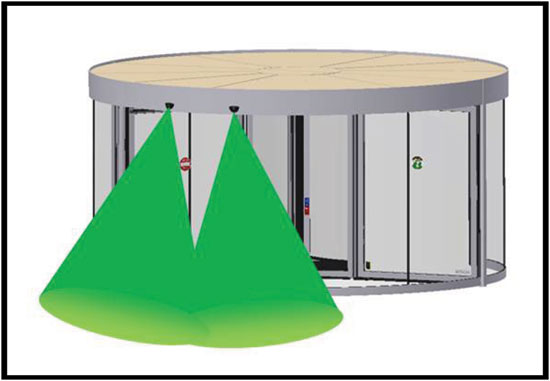
Image courtesy of Boon Edam
Motion sensors in front of the throat opening are used to begin rotation of the door when a user approaches.
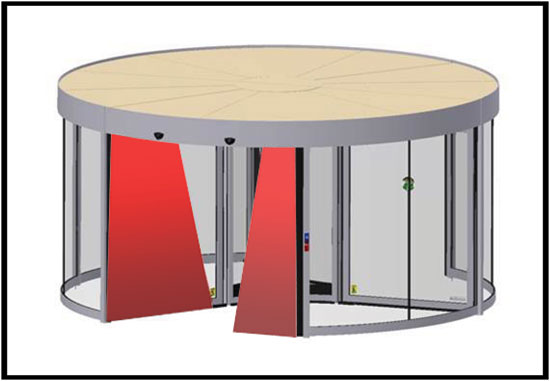
Image courtesy of Boon Edam
Infrared safety sensors on the top rail and right side of the throat opening prevent contact with users or objects.
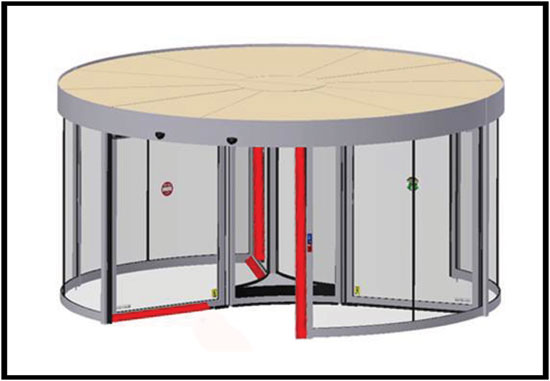
Image courtesy of Boon Edam
Rubber contact switches are redundant methods of stopping the door.
As can be seen in the accompanying illustration, the safety sensor in a trailing door wing can detect the presence of an object that falls within a certain area, and slow down or stop the door if activated. Note that these safety sensors will affect the usable compartment space and maximum traffic of an automatic door. For a larger compartment space, the drum diameter should be increased. Boosting a 12-foot-diameter door to a 14-foot-diameter, for example, can result in a 35 percent increase in compartment size and allow more traffic.
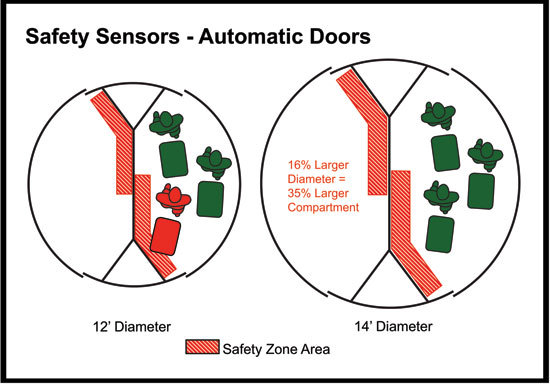
Image courtesy of Boon Edam
Emergency egress is one of the main issues when considering the main entrance to a building, and ANSI requires that a swing or slide door shall be installed next to the revolving door in the same building plane. Both the International Building Code (IBC) and the National Fire Protection Agency (NFPA) require a minimum of one door be installed within 10 feet of the revolving door. This is in case a revolving door malfunctions or becomes obstructed, or to accommodate those who do not wish to use the door because of a physical disability or other reason.
As mentioned earlier, revolving doors must be equipped with bookfolding door wings, creating a free passage that can be used as a supplemental emergency exit of a building in addition to dedicated emergency doors. In a book-fold operation, all wings collapse parallel to each other and to the egress direction, creating two openings of equal width, the sum of which must not be less than 36 inches. This will accommodate pedestrians on each side of the opening. Collapsing force—the weight at which doors must collapse under pressure—should be less than 130 pounds if the door is a means of egress, and less than 180 pounds if it is not a means of egress. This is according to the NFPA, IBC and ANSI 156.27. The codes agree that “ Each revolving door wing shall be capable of breakout when a force 130 pounds is applied at a point 3 inches from the outer edge of the outer wing stile and 40 inches above the floor. An exception is two wing doors with automatic sliding or collapsing center panels per 7.3 are excluded.” Both the IBC and NFPA state that revolving doors shall not be given credit for more than 50 percent of the required egress capacity of a building, and that each individual door shall be credited with no more than a 50-person egress capacity.
Further, if a stairway or escalator in front of a revolving door delivers passengers at a rate that exceeds door capacity, lines of people can crowd the area, creating unsafe congestion. Consequently, a dispersal area between the stairways or escalators and the revolving doors is required to enable safe and orderly egress. In addition, the revolving door must not be closer than 10 feet from the exit point of the stairway or escalator.
ANSI 156.27 also requires that there be specific signage on automatic revolving doors, including an “Automatic Door” sign, an “Emergency Stop” button and a “Push to Slow” button posted on the doors. Most manufacturers can offer additional safety measures such as visual signage on the door wings and drum to ensure the safety of doors for all user groups. Architects should contact the revolving door manufacturer for aftermarket decals to be affixed to the glass on the revolving doors. Another feature offered by many manufacturers is voice communication, which announces “please move forward” or a similar message when a user has triggered a presence detection sensor on an automatic door and the door has been slowed or stopped.
Architects should be aware, however, that codes are always subject to the interpretation and approval of local enforcement authorities. If in doubt, the door manufacturer can be a good source of advice on code implications for a specific project.
Specifying a Revolving Door
As a recap, properly specifying a revolving door is dependent on a number of factors. A check list is presented below.
• Determine the capacity needed for each entrance and consider the benefits of a larger-diameter door.
• Clearly delineate whether a manual or automatic revolving door is necessary.
• Make specifications consistent with architectural details.
• Make specifications consistent with the manufacturer's door model selected as the basis of specification.
• Carefully choose the number of door wings—three or four—and detail the plan view consistently.
• Indicate the desired dimensions for diameter, door opening height, and height under canopy as well as canopy height.
• Specify a finish for the canopy of the revolving door system. The basics to consider here are whether the canopy will be visible from above and whether it is exposed to the outside elements.
• Determine security needs. Will night sliding doors be required? Prevention of tailgating or piggybacking? Do security concerns warrant remote locking and card readers?
Manual revolving doors must utilize a speed control device to comply with applicable buildings codes. Generally a speed control device will be mounted in the standard overhead location in the canopy structure; a floor-mounted location is optional, and typically used with a glass ceiling. Deadbolt locks are typically top-rail mounted and can engage the door ceiling to secure the door panels from rotating. Deadbolt locks can also be mounted on the door bottom rail and locked into the floor with a dust-proof strike , usually if the door opening height is above 7 feet 6 inches or greater. Activation and safety sensors are not necessary in manual revolving doors and should not be specified. Floor mats, carpet tiles, grills and grates can be referenced in a revolving door specification but should be specified in Division 5, 9 or 12.
For automatic revolving doors, safety sensors should be specified per ANSI 156.27, both Infrared presence detectors and rubber contact switches for a redundant and overlapping capability. “Showcase” and throat opening sensors are recommended. Specify electric shaft and electric wing locking to provide remote locking capability as well as stability in windy conditions. Note that power assisted, “push to start” capabilities are not acceptable per ANSI as ANSI requires external activation sensors mounted on the outside canopy or ceiling at the opening. Neither speed control units nor push bars should be specified—these are exclusively the province of manual door attributes.
Revolving Doors—Sustainable, Safe, Comfortable
With rising energy costs and clients' growing demand for comfortable, safe, and environmentally sustainable building, revolving doors can be a true asset. Revolving doors are the most energy-efficient entrance solutions available today. The “always open, always closed” principle of a revolving door ensures that the conditioned inside air and the unconditioned outside air remain separated, preventing drafts, dust, and noise coming into the building. As less energy is required to maintain the conditioned climate inside the building, revolving doors help reduce the carbon footprint of a building and save both energy and cost—key assets in today's building environment.
 |
Royal Boon Edam is a global market leader in entry solutions. Headquartered in the Netherlands, with 140 years of experience in engineering quality, the company has gained extensive expertise in managing the movement of people
through office buildings, airports, healthcare facilities, hotels, and many other types of buildings.
www.boonedam.us |



























